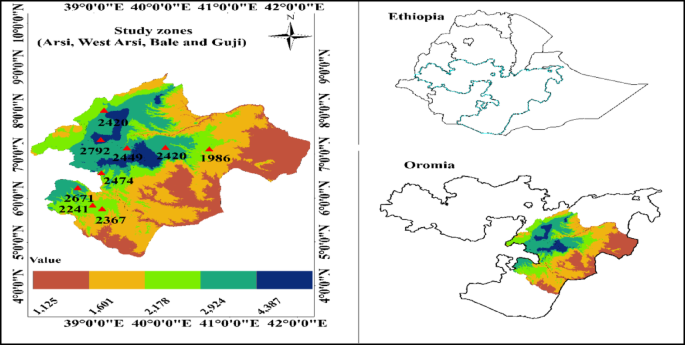The article analyzes the descriptive statistics of agroclimatic extremes related to rainfall and temperature across nine meteorological stations in southeastern Oromia, Ethiopia, over a 30-year period (1994-2023).
Key Findings:
-
Precipitation Extremes:
- Consecutive Dry Days (CDD): Average of 52 days/year with significant variation among stations. Areas such as Ginir and Asela exhibit higher CDD (58-61 days), while Bore has fewer (44-46 days). Variability attributed to topography and climate change.
- Consecutive Wet Days (CWD): Average of 16 days/year, with fluctuations noted; Agarfa showed the minimum and Bokoji the maximum.
- Rainfall Intensity (SDII): Average of 7.1 mm/day/year with considerable variability. Highest recorded at Adola (9.0 mm) and lowest at Sinana (5.3 mm).
- Heavy Rainfall Days: Average of 27 days/year for precipitation exceeding 10 mm, varying greatly by region (17 at Sinana to 40 at Bore).
-
Temperature Extremes:
- Cool Nights (TN10P): Average of 11% (~40 days/year) indicating low variability. Areas like Adola had fewer cool nights.
- Warm Nights (TN90P): Average of 10.9% with consistent upward trends; districts like Ginir and Dodola showed positive trends.
- Daily Maximum Temperature (TXx): What appears to be a warming trend, with notable increases across most stations.
-
Temporal Trends:
- Overall, 33.3% of stations showed increasing trends in total wet-day rainfall (PRCPTOT), with some stations experiencing significant decreases, indicating rising water security challenges. Mixed trends exist for very wet days (R95P and R99P) across different stations, suggesting divergent local climatic influences.
- Extreme Temperature Trends: Nearly all stations indicate a warming trend, particularly for warm day and night indicators, contrasting with declines in cool temperature metrics.
- Conclusions:
- A complex interaction between local climate variability, topography, and meteorological patterns impacts farming, water management, and regional planning.
- The results underscore the necessity for localized adaptation strategies to mitigate the adverse effects of these climatic changes on agriculture and ecosystems.
This comprehensive analysis highlights the urgent need for attention to climate impacts in southeastern Oromia amid evolving agroclimatic conditions.


